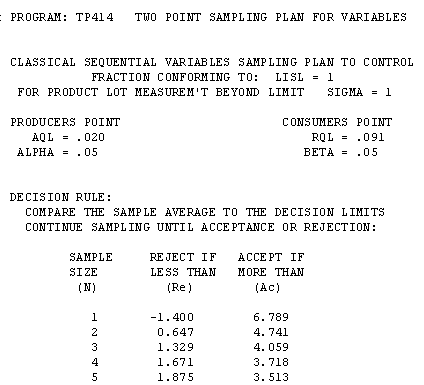

Ansi Z1.9 Calculator Full Size Ansi
The vertical axis is the probability of accepting the lot. Aql sampling calculator AQL Nkqun.In constructing a chart, the horizontal axis is based upon the actual percent of non-conforming product in the lot. More the full size Ansi Table Calculator image. 065 to 15.ANSI/ASQ Z1.4 & Z1.9 Sampling Plan Standards for Quality.
This is the distribution to use when sampling without replacement, i.e. In the above example P(1) = 46%So you would accept this lot 86% of the time if you rejected the lot when you found two non-conforming parts.I hope that this gives you the help that you needed.TomF is correct in stating that acceptance sampling is based on the hypergeometric. ASQ/ANSI Quality Standards Z1.4 & Z1.9.The purpose of this analysis is “what if I had 5% non-conforming, what is the probability of accepting a lot of 100 parts taking a sample of 13 parts and rejecting the lot with two non-conforming parts.” The ideal situation is that you would accept 100% of the lots up to a certain percentage of non-conformance than you would accept none of the lots.Now for the math, the hypergeometric distribution is defined as:P(x) = combin(d,x)*combin (N-d,n-x)/combin (N,n)Where d is the actual number of non-conforming parts, n is your sample, and N is the lot size.Using smaller numbers, the probability finding zero non-conformances by taking a sample of 3 parts out of 20 parts with 5 non-conforming parts is:P(0) = combin (5, 0)*combin(95, 5)/combin (100, 10) = 1* 455/1140 = 40%Note that if your reject number is two non-conforming parts then you have to calculate P(1) also. Fill in the calculator to easily find your. Variation may be measured by sample standard deviation, sample range, or known standard deviation.Our calculator is based on the AQL tables but gives you a fast answer. It provides tightened, normal, and reduced plans to be used on measurements which are normally distributed.
But if the lot size is 1000 and two are selected the probability of reselection is small ( 1 in 1000). That is, if the lot size is 10 and 2 are selected, the probability of reselecting the same part if it is replaced is high ( 1 in 10). There are sites available on the net where you can find individual large number probabilities and MINITAB will do this also.However, in many cases, wheter replacing an item or not, the probability of selecting the same item for inspection again is not affected to any degree. If you try to put a lot size greater than about 3000 for instance into Excel, it cannot calculate the probabilities. But the math is difficult because of the large factorials.
2 is usually a good range in steps of 0.0005 or whatever resolution you desire. A place the percent defectives as decimal, i.e from say 0.0005 (.05 % defective) to. There is another ANSI spec on isolated lots which uses the hypergeometric.You can easily generate the curves in Excel. In turn this binomial may be approximated by the Poisson when np is less than 5 and by the normal when np > 5.The ANSI spec you cite is based on the binomial approximation and the Poisson when the approximation conditions apply as it is actually the probability of a sequence of many lots being accepted from a process with a proportion defective of (AQL)%. This distribution is extensively tabulated and simple spreadsheet programs can do the math.The usual rule of thumb is to use the binomial approximation to the hypergeometric when the sample is less than 10% of the lot.
Schilling from ASQC press. If you want a very detailed explination of these concepts, the standard reference work is ACCEPTANCE SAMPLING IN QUALITY CONTROL, Edward G. This should match the ANSI curves.Hope this helps. B use the BINOMDIST function and put in parameters of acceptance number Ac for number of successes, sample size n for trials, the column A cell reference for probability of success and True in the cumulative function.You can then graph the probability of acceptance Pa in the B column vs the per cent defective in the A column.
Ansi Z1.9 Calculator How To Set Up
Reply to this posting with contact information if you are interested in how to set up OC curves in Excel using the hypergeometric.However, Excel lets you calculate both the mass and cumulative density functions for both the binomial and the Poisson distributions (that last little statement on the end of the function). This makes it a little more difficult to construct OC curves on Excel using the hypergeometric, but not impossible. How does this compare with the results from the hypergeometric?Note that the hypergeometric function in Excel only returns the mass function — Pr (X=x). To approximate using the binomial, type in =binomdist(x,n,p, false), where x=n=6, and p=n/N=6/54.As a neat trick, type in =combin(N,n) where N=54 and n=6. The Texas Lotto has 54 possible numbers, and you win by matching 6 out of 6.If you use Excel, type in =hypgeomdist(x,n,D,N) where x=n=D=6, and N=54 to get the exact.

This 3% (actual 2.78%) difference is usually considered an acceptable rounding difference.


 0 kommentar(er)
0 kommentar(er)
